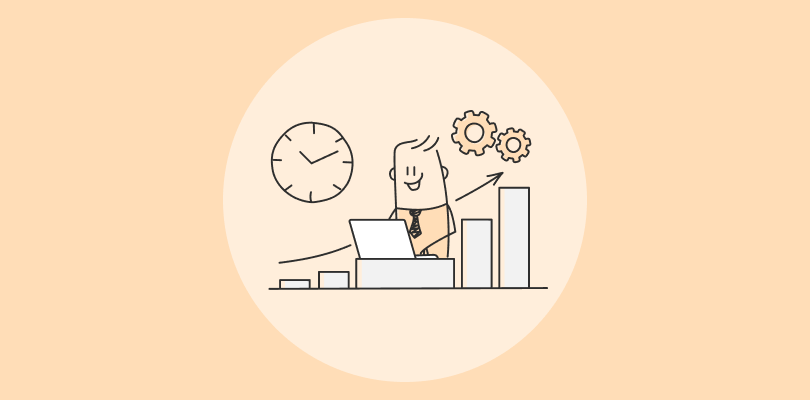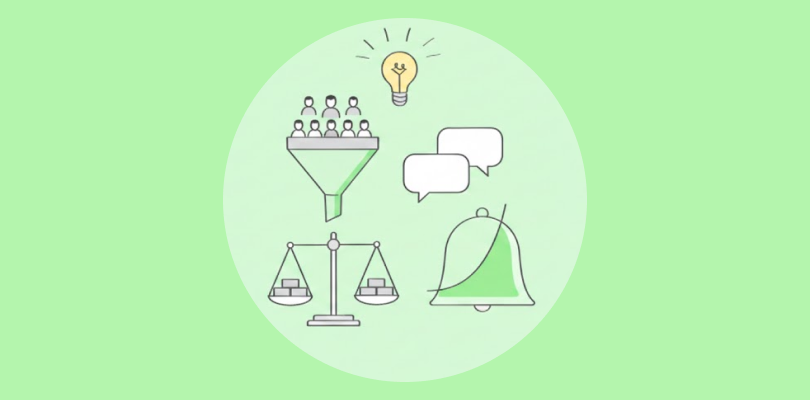Let me tell you straight: a Performance Improvement Plan (PIP) is not a career death sentence; it’s a reset button for performance.
Done right, it’s a structured chance for an underperforming employee to reset, grow, and succeed. Over the past five years, I’ve worked with over 500 HR managers and business leaders, reviewing 1,000+ performance cases where PIPs turned struggling employees into consistent performers.
Those experiences taught me what separates plans that work from those that fail.
So in this blog, I will use that experience to help you learn how to:
- Write a performance improvement plan, step by step.
- Avoid costly HR and legal mistakes.
- Apply real-world examples and templates.
Follow the process, and you’ll know how to design PIPs that deliver measurable results and lasting trust.
Let’s start with a fundamental question:
What Is a Performance Improvement Plan (PIP)?
A Performance Improvement Plan (PIP) is a formal plan that identifies areas where an employee is not meeting expectations and lays out a structured path to improve. It usually sets specific goals, outlines the support or training available, and provides a defined timeline, such as 30, 60, or 90 days.
The purpose is not only to protect the organization but also to give the employee a fair chance to succeed with clear direction and resources.
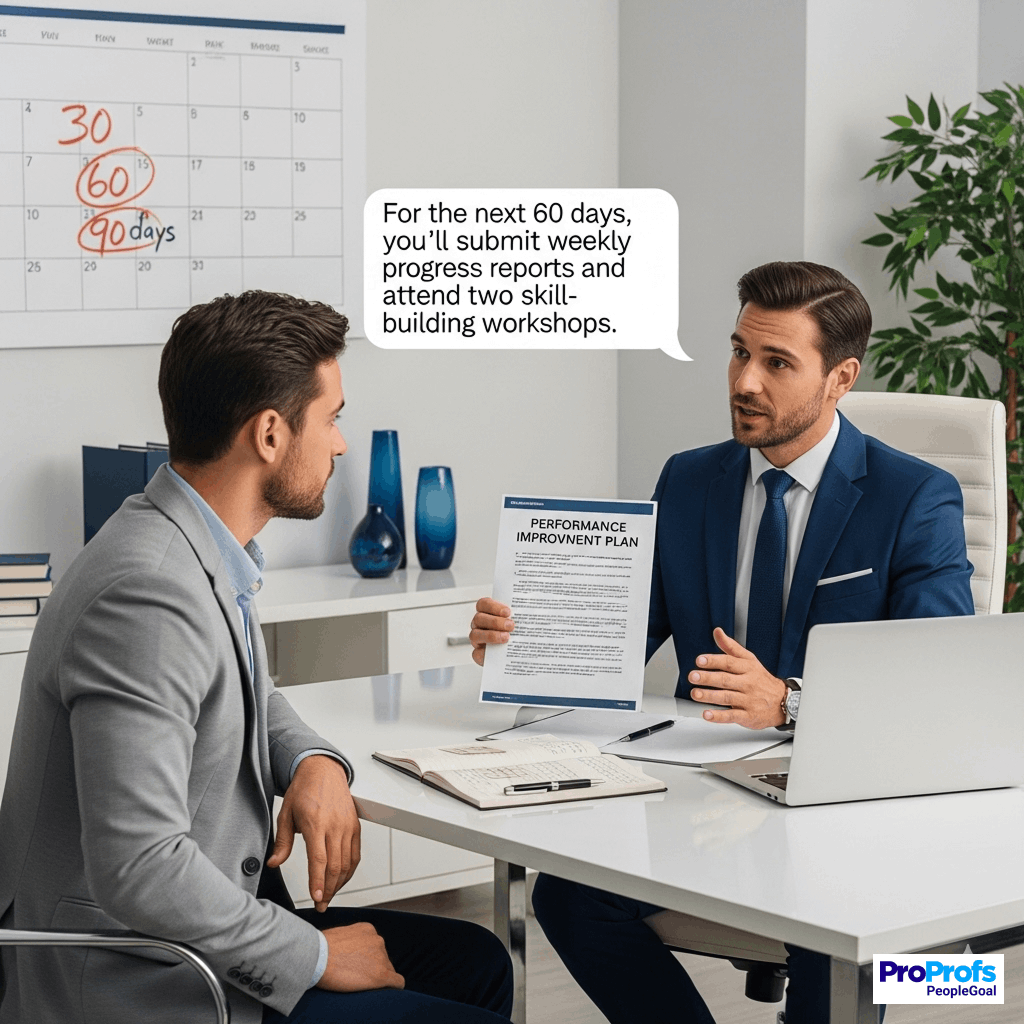
Some managers even call it a ‘PIP improvement plan,’ but what they really mean is a formal performance improvement plan designed to help employees succeed.
Let me explain this with an example:
I once worked with a project coordinator who repeatedly missed deadlines and delivered incomplete reports. Instead of letting frustration build, I created a PIP. The plan required her to submit weekly task updates every Friday, attend a time-management workshop, and meet with me for bi-weekly check-ins.
We also agreed on measurable goals: no more than one late task in the next 60 days and reports with zero missing data fields. With this structure, she had both accountability and guidance.
By the end of the second month, she was consistently on time, her reports were complete, and she regained the trust of the team.
Sounds good?
Now, let’s understand step by step how to actually write and implement a performance improvement plan that works in real situations.
How to Write a Performance Improvement Plan
A PIP is not a formality. Rather, it’s a structured process that requires precision, fairness, and ongoing involvement. Here’s a detailed guide, with tools that can help you adapt things right away.
1. Diagnose the Performance Issues & Gather Evidence
You cannot solve what you cannot define. Begin by understanding the problem thoroughly.
- Document specific behaviors. Replace vague notes like “unreliable” with: “Missed 3 out of 5 project deadlines in Q2, causing client delays.”
- Use multiple data sources. Pull from reports, performance reviews, customer complaints, or peer feedback.
- Distinguish between skill vs. will. Is the employee struggling because they lack training (skill) or because they’re disengaged (will)?
| Evidence Type | Example | Impact |
| Missed Deadlines | Report submission was delayed by 5 days in April | Client escalated the issue |
| Quality Errors | 6 coding errors in the last release | Increased rework hours |
| Customer Complaints | 3 complaints logged in May | Damaged satisfaction score |
2. Define SMART Goals That Address the Gap
Goals must be concrete and measurable, not subjective. SMART goals bring clarity.
- Bad goal: “Be more reliable.”
- Good goal: “Submit 100% of weekly status reports by 3 PM every Friday for the next 60 days.
- Sales example: “Close 3 new accounts and achieve at least 80% of quota in Q3.
- Support role example: “Achieve an average response time under 24 hours for customer tickets over the next 45 days.”
Quote to use in conversations: “These goals aren’t about being perfect. They’re about giving us a fair way to measure progress.”
SMART Goals Checklist Table
| SMART Element | Question to Ask | Example |
| Specific | What exactly needs improvement? | Submit status reports on time |
| Measurable | How will progress be tracked? | 100% on-time submission |
| Achievable | Is this realistic? | Yes, one report per week |
| Relevant | Does it address the real issue? | Yes, improves accountability |
| Time-bound | By when? | Every Friday for 60 days |
3. Align With HR Policies and Create an Action Plan
A plan is only as strong as its fairness. Align the PIP with company rules and make sure support is included.
- Check consistency. If most PIPs last 60 days, don’t give someone 15 without cause.
- Add resources. Example: provide training, job shadowing, or mentoring.
- Define managerial support. State what the supervisor will do: weekly coaching, feedback emails, or progress reviews.
Sample Action Plan
| Action | Responsibility | Deadline |
| Attend Excel training | Employee | Within 30 days |
| Weekly coaching meeting | Manager | Every Monday |
| Submit weekly progress log | Employee | Every Friday |
| Review progress and adjust | HR | Midpoint (Day 30) |
4. Meet With the Employee and Explain the Plan Clearly
Delivery matters. The first meeting frames the entire process.
- Be respectful. Say: “We value your work, but we need to address these gaps. This plan is designed to help you succeed.”
- Allow input. Ask: “Do you feel these goals are realistic with the support we’re offering?”
- Clarify consequences. State what happens if goals are not met—without sounding threatening.
- Document acknowledgment. Use a signature line or a note by HR if the employee refuses to sign.
5. Monitor Progress Through Regular Check-Ins
A PIP fails if left unattended. Monitoring is continuous, not occasional.
- Weekly reviews. Schedule them upfront. Example: every Friday at 2 PM.
- Celebrate wins. “Your last three reports were on time—excellent progress.”
- Address setbacks immediately. “You missed this week’s target. What’s the obstacle, and how can we fix it?”
- Keep written notes. Each meeting becomes part of the documentation trail.
Mini Progress Tracking Table
| Week | Goal | Status | Notes |
| 1 | Report submitted Friday, 3 PM | ✅ | On time |
| 2 | Report submitted Friday, 3 PM | ❌ | 1-day late |
| 3 | Report submitted Friday, 3 PM | ✅ | Improved |
6. Evaluate the Outcome and Decide Next Steps
At the end of the timeline, assess fairly and act consistently.
- If successful: Celebrate and reintegrate the employee into normal performance reviews. “You’ve met your goals, and that proves you’re back on track.”
- If partially met: Consider extending once with new goals. Avoid indefinite extensions.
- If unsuccessful: Apply the stated consequences. Ensure this step is consistent with HR policy and documented.
Decision Matrix Example
| Outcome | Action | Message to Employee |
| All goals met | End PIP, resume standard reviews | “You’ve shown consistent improvement—well done.” |
| Partial goals met | Extend plan 30 days | “You’ve improved in X, but we need to see Y consistently.” |
| Goals unmet | Follow through with termination or reassignment | “Unfortunately, the required improvements weren’t met. Here are the next steps.” |
Now that you know the exact steps to create an employee performance improvement plan, the next question is when to actually use it. Not every performance problem requires a PIP in HR, and knowing when to apply one is as important as writing it correctly.
Let’s explore the right scenarios for using a performance improvement plan and when an alternative approach is better.
When to Use a PIP and When to Choose Other Actions
A performance improvement plan (sometimes called a performance action plan or employee performance plan) is most effective when applied in the right context. Here are the key guidelines.
Use a PIP for Recurring and Measurable Problems
A PIP works best when an underperforming employee shows a consistent pattern of missed goals. The issues should be tied to work performance improvement that can be tracked with numbers or behaviors.
Example: A sales executive who misses quota three months in a row can be placed on a PIP that requires 80% quota achievement in the next quarter.
Use a PIP After Feedback Hasn’t Worked

If informal coaching or feedback sessions don’t resolve the problem, a PIP formalizes expectations.
Example: A customer service representative who has been verbally reminded about response times but continues to take over 48 hours to reply can be placed on a plan requiring 24-hour responses for 60 days.
Do Not Use a PIP for Misconduct or Serious Violations
PIPs are designed for employee performance improvement, not for disciplinary issues. Misconduct like harassment, theft, or breach of company policy should be addressed with direct disciplinary measures, not a PIP.
Do Not Use a PIP for One-Time Mistakes
An isolated mistake usually requires coaching, not a formal plan.
Example: If an employee misses one deadline due to illness but otherwise performs well, a quick discussion is more appropriate than drafting a PIP.
Consider Alternatives When the Issue Is Systemic
If performance issues stem from poor processes or a lack of resources, an employee development plan or team-wide training may be more effective than individual PIPs.

Example: If three employees consistently fail to use a new CRM tool, the solution might be better training or clearer guidelines, not three separate PIPs.
Okay.
We’ve seen when a performance improvement plan is useful and when it’s not. But even the most carefully written plan can backfire if you ignore legal and HR aspects. A PIP in HR is more than paperwork; it’s also about fairness, compliance, and protecting both the employee and the organization.
Legal and HR Considerations You Must Address
An employee performance improvement plan should always be designed with fairness and consistency in mind. From documentation to employee rights, every part of the process should meet basic HR and legal standards. Let’s look at the key considerations.
Fair Process and Documenting Performance Issues
For a PIP to hold credibility, it must be supported by evidence. Managers need to show that the plan is based on real performance problems, not personal opinions.
- Keep written records of missed deadlines, quality errors, or customer complaints.
- Link every issue to its impact, such as delays in delivery or lost revenue.
- Use facts and numbers rather than vague terms like “unreliable” or “bad attitude.”
Example: Instead of writing “Employee often late with tasks,” record “Employee missed 3 of 5 reporting deadlines in April, causing client delays.”
Avoiding Discrimination and Retaliation
A PIP should never be misused as punishment for protected actions or personal traits. It must remain tied to work performance improvement only.

- Do not put an underperforming employee on a plan because they filed a complaint or requested medical leave.
- Apply the same standards to everyone in similar roles.
- Review the plan with HR to confirm it reflects company-wide consistency.
Tip: Courts often look at whether other employees with the same performance issues were treated the same way.
Employee Rights During a Performance Improvement Plan
Employees have certain rights while on a PIP. Respecting these rights ensures fairness and maintains trust.
- Provide a clear explanation of performance gaps and expectations.
- Give access to resources such as training or coaching to support employee performance improvement.
- Allow the employee to respond in writing or add rebuttals to the employee performance plan.
Reminder: An employee’s refusal to sign the PIP doesn’t invalidate it. Document the refusal and note that it was presented.
Alignment With HR Policy
A plan should always align with the company’s HR policy and past practices. Inconsistencies can create the perception of bias.
- Match the usual PIP duration (e.g., 30, 60, or 90 days).
- Follow internal rules for reviews, extensions, and consequences.
- Make sure timelines and expectations are reasonable and achievable.
Example: If one employee gets 60 days to improve, giving another just 15 days without reason could be seen as unfair.
At-Will Employment and Termination Decisions
In many regions, employees work under at-will terms. That means termination can happen without a PIP. Still, using a performance improvement plan shows good faith.
- Demonstrates that the company gave the employee a chance to succeed.
- Provides documentation that supports decisions in case of legal disputes.
- Protects the organization while offering a path for work performance improvement.
Practical Advice: Always close a PIP with a written summary letter, whether the outcome is improvement, extension, or termination.
Now that you’re aware of the legal and HR considerations behind a performance improvement plan, the next step is knowing what to actually include in the document.
A PIP in HR only works when its components are clear, practical, and measurable. Let’s look at the essential building blocks of an effective employee performance plan.
The Core Components of an Effective Performance Improvement Plan
A performance improvement plan becomes effective only if it contains the right elements. Each part has a purpose, from clarifying issues to setting timelines, and together they ensure the plan is fair, measurable, and actionable. It has elements such as:
A Clear Statement of the Performance Issue
Every performance improvement plan must begin with a precise explanation of the problem. This is where documenting performance issues plays the most important role. The statement should avoid vague descriptions like “bad attitude” and instead focus on facts.
For instance: “Over the last three months, the employee has missed four major client deadlines, resulting in project delays.”
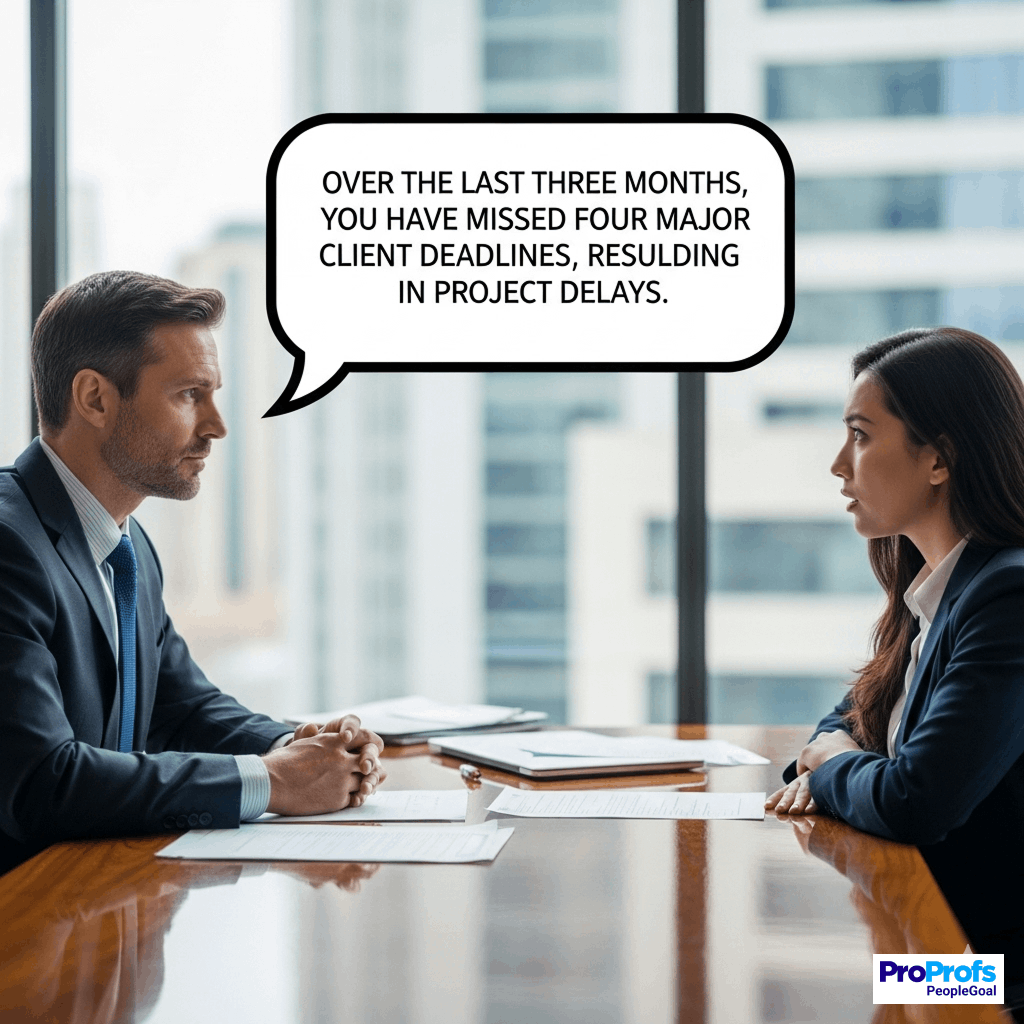
This level of detail ensures that the plan is objective and that the underperforming employee knows exactly what behavior needs to change.
SMART Goals That Define Performance Expectations
The second component of an employee performance plan is the set of goals the employee is expected to meet.
These should be SMART—Specific, Measurable, Achievable, Relevant, and Time-bound. Rather than simply stating “improve sales performance,” the plan might specify: “Achieve 85% of the monthly sales quota for the next 60 days.”
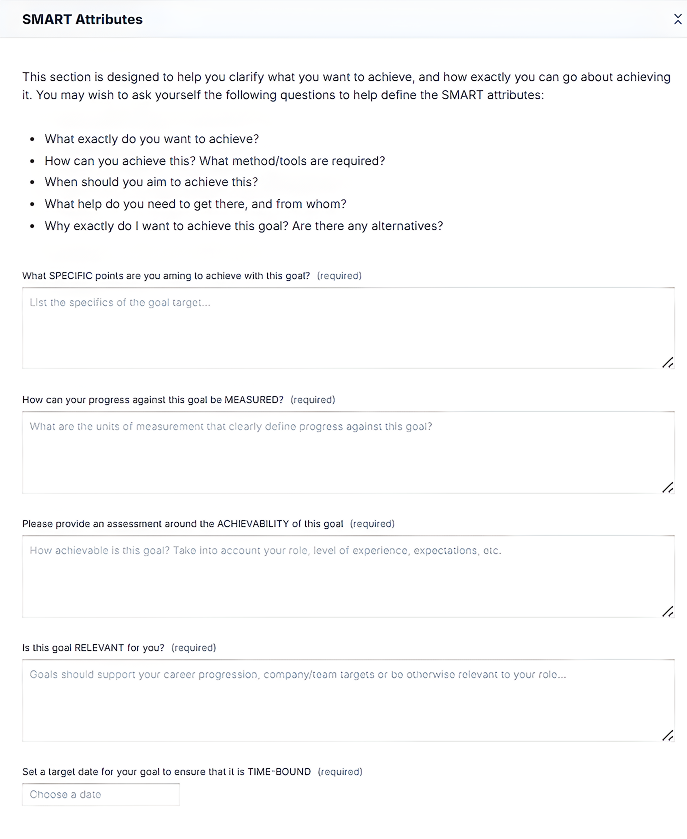
Clear targets transform the PIP from a vague warning into a roadmap for employee performance improvement and long-term work performance improvement.
An Action Plan That Provides Support
A performance improvement plan cannot succeed if it only demands results without offering resources.
The action plan section describes how the company will support the employee in reaching their goals. This may involve enrolling them in training, assigning a mentor, or setting up weekly coaching sessions.
A good example is adding a line such as: “The employee will complete a customer service training course within 30 days and meet with the supervisor every Friday for progress feedback.”

This approach frames the PIP not as a punishment, but as a structured opportunity for growth.
Defined Timeline and Milestones
Without a timeline, a PIP has no urgency or accountability.
Most plans run for 30, 60, or 90 days, depending on the severity of the issues. What matters is setting milestones that allow managers to measure progress along the way.
For example, a 60-day plan may include a mid-point review at Day 30 to check whether the work performance improvement targets are being met. A timeline ensures both sides know when progress will be assessed and avoids confusion about the end date.
Consequences of Not Meeting the Plan
Transparency is vital in any performance improvement plan. Employees need to understand what happens if they fail to meet the expectations. The plan should outline possible consequences, extension, reassignment, or termination, without sounding threatening.
Phrasing like “Failure to meet these expectations may result in further action, up to and including termination” is clear and professional.
This section reinforces accountability and ensures the employee knows the stakes.
Acknowledgment and Ongoing Monitoring
Finally, every PIP should close with acknowledgment and a monitoring method. Having the employee sign the plan shows that it was received and discussed, even if they disagree.
The monitoring method, such as weekly one-on-ones or progress reports, sets the rhythm for the plan. Documenting each session not only tracks employee performance improvement but also protects the organization if disputes arise later.

So far, you’ve seen what goes into a performance improvement plan and why each component matters. However, a PIP in HR is not just about structure; it’s also about time.
Most plans are designed to run for a set number of days, with checkpoints that keep both the manager and the employee on track.
Let’s now look at how to use a 30-60-90 day format to effectively structure a performance improvement plan.
30-60-90 Day Structures and Checkpoints in a Performance Improvement Plan
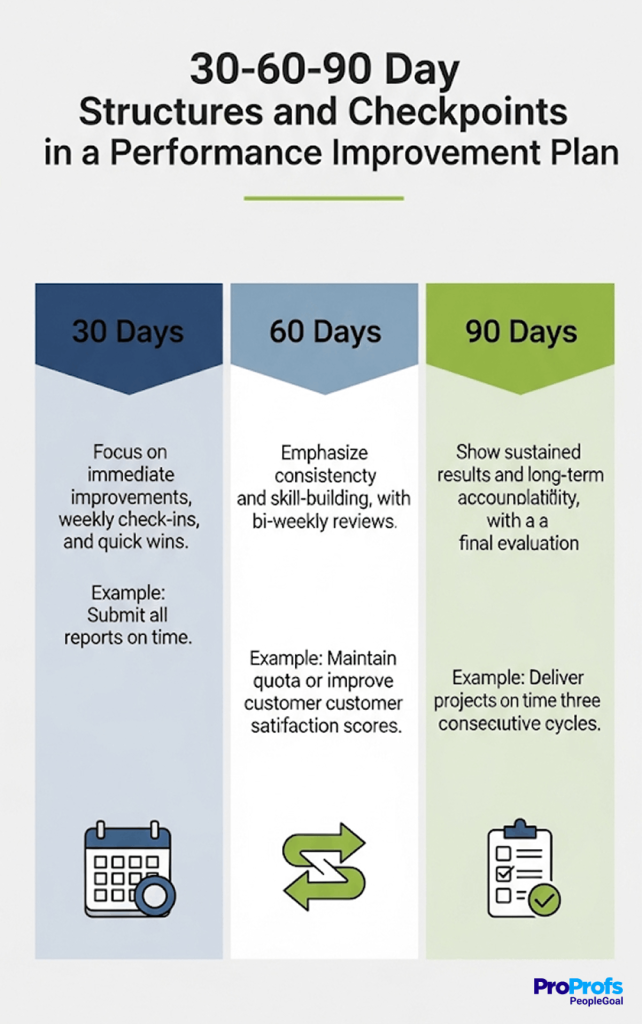
A performance improvement plan is typically designed to run for 30, 60, or 90 days. The right duration depends on the nature of the issues and the goals for employee performance improvement. Here are some elements to consider:
30-Day Focus: Immediate Improvements
The first month is about addressing the most urgent performance issues. The goals here are short-term and designed to create quick wins.
Example: A customer support agent may be required to reduce response time from 48 hours to 24 hours within 30 days.
Managers often use this stage for weekly check-ins and documenting performance issues that are resolved or persist.
60-Day Focus: Consistency and Skill Building
The second phase tests whether the employee can sustain improvements and develop new skills. This is where work performance improvement becomes visible.
Example: A sales representative who achieved quota in the first month must maintain at least 80% of the quota in the second.
Training sessions, coaching, or mentoring are often added here as part of the employee performance plan.
90-Day Focus: Long-Term Results
If a plan runs the full 90 days, the final stage is about proving that improvements are lasting, not temporary.
Example: An underperforming employee in project management may need to deliver three consecutive projects on time and within budget.
By this point, the manager should have enough data to evaluate whether the employee has truly achieved employee performance improvement or if further action is necessary.
Sample 30-60-90 Day PIP Framework
| Timeline | Goal | Checkpoint | Support Provided |
| 00–30 Days | Correct immediate issues (e.g., late reports) | Weekly manager reviews | Job shadowing + feedback |
| 31–60 Days | Maintain improvements, build new skills | Bi-weekly reviews | Training workshop, HR check-in |
| 61–90 Days | Demonstrate consistency over time | Final review | Access to resources, coaching |
So far, we’ve looked at the structure and timing of a performance improvement plan. But theory alone doesn’t show how it plays out in the real world.
To make this concrete, let’s walk through detailed examples of performance improvement plans across different roles.
Performance Improvement Plan Examples (With Scenarios)
Here are some practical scenarios and examples of performance improvement plans that can easily work for you. Check them out.
1. Sales Performance Improvement Plan Example
Scenario:
Mark is a sales representative who has consistently missed his targets for three quarters. His quota is 20 new accounts per quarter, but he has been closing only 8–10. His manager wants to use a sales employee performance plan instead of terminating him immediately.
Plan Details:
- Performance Issues (documented): Mark closed 9 accounts in Q1, 8 in Q2, and 10 in Q3. Targets were missed by at least 50%.
- SMART Goals: Achieve at least 15 new accounts in Q4 (75% of quota) and maintain a pipeline of 50 active leads.
- Action Plan: Mark will attend advanced sales training, schedule five client calls daily, and share weekly progress updates with his manager.
- Timeline: 60 days, with a checkpoint at 30 days.
- Support Provided: Weekly coaching sessions, access to a sales mentor, and new CRM tools for lead tracking.
- Outcome: At the 60-day review, Mark had closed 12 new accounts and was on track to meet quota, showing measurable work performance improvement.
2. Customer Service Performance Improvement Plan Example
Scenario:
Anna, a customer service associate, has been receiving negative customer satisfaction scores. The last three surveys show an average rating of 2.8/5 when the company standard is 4.0. Her supervisor decides to create a performance improvement plan instead of moving straight to a warning.
Plan Details:
- Performance Issues (documented): Anna received five complaints in the last month about slow responses and incomplete resolutions.
- SMART Goals: Achieve an average CSAT score of 4.0 or higher in the next 60 days and reduce average response time to under 24 hours.
- Action Plan: Attend a customer service workshop, shadow a senior associate twice a week, and submit a weekly self-assessment log.
- Timeline: 60 days with bi-weekly reviews.
- Support Provided: Manager role-playing sessions, resource guides, and access to a mentor for complex cases.
- Outcome: By the end of the plan, Anna improved her CSAT to 4.2 and maintained a 20-hour average response time, meeting her employee performance improvement goals.
3. Technical Role Performance Improvement Plan Example
Scenario:
David, a software engineer, has been making frequent coding errors that require rework from his peers. In the last sprint, his code had 15 bugs compared to the team’s average of 5. His manager initiates a technical employee performance plan to address quality concerns.
Plan Details:
- Performance Issues (documented): High defect rate—15 bugs reported in one sprint, causing an extra 20 hours of rework.
- SMART Goals: Reduce coding errors to fewer than 5 per sprint over the next 90 days. Complete all code reviews on time.
- Action Plan: Pair programming twice a week, attend a clean coding workshop, and use automated testing tools.
- Timeline: 90 days, with checkpoints at 30 and 60 days.
- Support Provided: Access to a senior developer as a mentor and additional QA resources.
- Outcome: By Day 90, David had reduced his bug count to 3 per sprint, successfully meeting the performance improvement plan goals.
4. Project Management Performance Improvement Plan Example
Scenario:
Lisa, a project coordinator, has struggled with meeting deadlines and communicating progress. In the last two projects, delivery was delayed by two weeks. A performance improvement plan is created to help her strengthen time management.
Plan Details:
- Performance Issues (documented): Two consecutive projects were delayed; weekly reports were not submitted.
- SMART Goals: Deliver the next two projects on time and submit weekly progress reports every Friday for 60 days.
- Action Plan: Use project management software daily, attend a time-management course, and meet with her manager every Monday.
- Timeline: 60 days with a midpoint review at Day 30.
- Support Provided: Access to new planning tools and a senior PM for guidance.
- Outcome: Lisa delivered her next project on time and consistently submitted weekly reports, demonstrating sustained work performance improvement.
Let’s take a breath before moving forward.
Okay, the previous section gave you real-world performance improvement plan examples, showing how they play out in different roles.
But creating the plan is only half the work. In fact, ensuring it actually succeeds requires best practices that managers and HR teams should follow.
Let’s now look at the dos and don’ts that can make or break a performance improvement plan.
Best Practices That Increase Performance Improvement Plan Success
A performance improvement plan is effective only when it is implemented thoughtfully. Managers must balance accountability with support and fairness. Here are some practical best practices.
Do: Focus on Root Causes, Not Just Symptoms
Many underperforming employees struggle because of training gaps, unclear instructions, or workload imbalances. Addressing the underlying issue is critical.
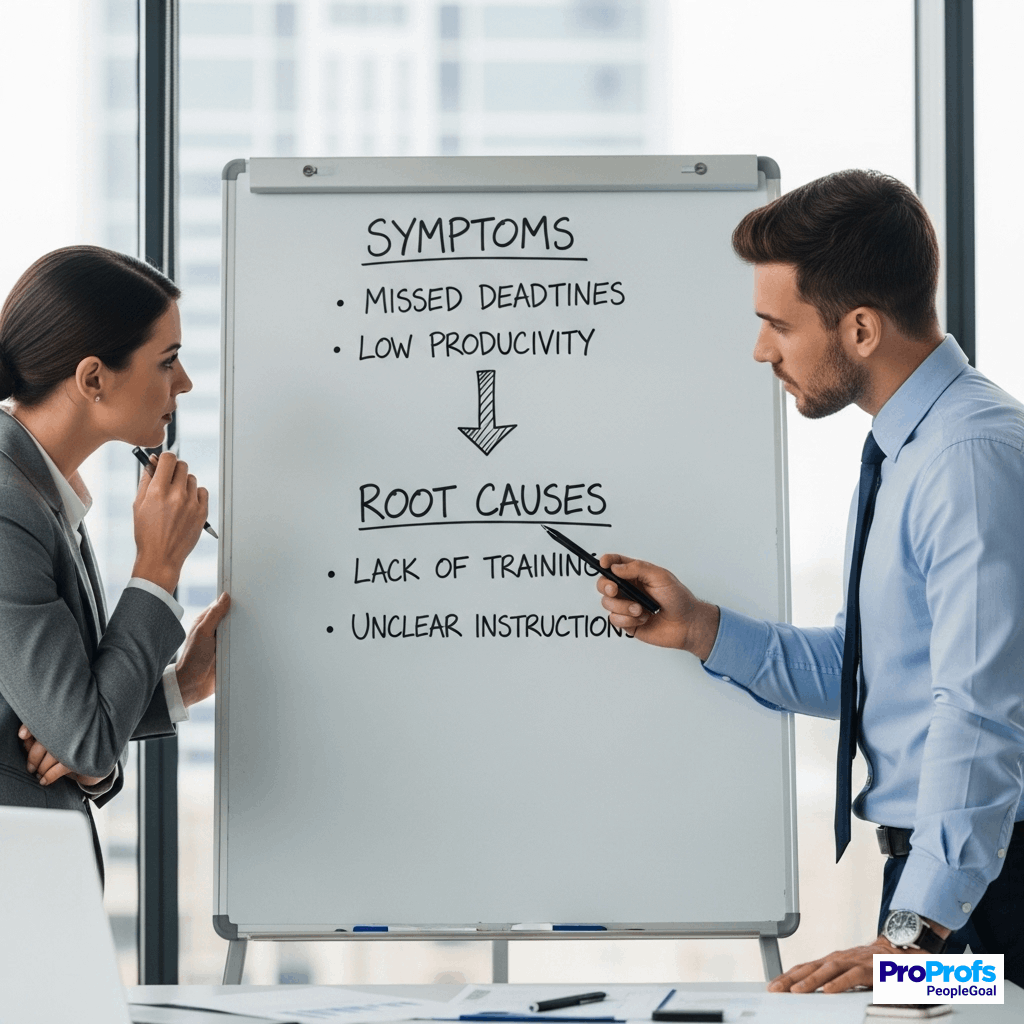
Identify whether it’s a skill gap (lack of training), a will gap (low motivation), or a resource gap (tools missing).
Example: If poor sales results stem from inadequate product knowledge, add training before expecting quotas to improve.
Do: Keep the Plan Specific and Measurable
Vague expectations make PIPs ineffective. Instead, use SMART goals to ensure measurable employee performance improvement. State exactly what needs to change: deadlines, quotas, or quality benchmarks.
Example: Replace “Be more reliable” with “Submit 100% of weekly reports by Friday, 3 PM for 60 days.”
Do: Provide Support and Resources
A PIP is not meant to leave the employee alone with problems. It should feel like a partnership. Offer access to mentors, training workshops, or new tools that help achieve work performance improvement.
Example: Provide time-management software and coaching sessions for a project coordinator who struggles with deadlines.
Don’t: Use PIPs as a Punishment
A performance improvement plan should be positioned as an opportunity, not a pretext for firing. Avoid language that feels like a verdict. Keep it constructive and supportive.
Example: Say, “We want to give you the tools to succeed,” not “This is your last chance.”
Don’t: Overlook Documentation
For a plan to be defensible and credible, documenting performance issues and progress is essential.
- Keep written notes from every review meeting.
- File all updates as part of the employee performance plan.
- Documentation protects the company in case of disputes and shows the plan was fair.
Don’t: Set Unrealistic Timelines
Expecting dramatic improvement overnight undermines the PIP. Use realistic durations, usually 30, 60, or 90 days. Match the timeline to the severity of the issues and the effort required to fix them.
Example: Skill-based issues (like learning new software) may need 90 days, while missed reports may only need 30 days.
We’ve looked at best practices for success, but sometimes a performance improvement plan fails not because of the employee, but because of the way it’s applied.
To help you avoid these mistakes, let’s examine common pitfalls.
Common Pitfalls in a Performance Improvement Plan
Even the best-written performance improvement plan can fail if it’s applied poorly. These pitfalls often prevent true employee performance improvement and can also damage trust or create legal risks.
Let’s check out some of the major ones:
Misusing a PIP as a Pretext for Termination
A performance improvement plan should never be used as a hidden step toward firing an underperforming employee. Doing so damages trust and lowers morale across the team. Instead, managers should only initiate a PIP when there is a genuine intent to achieve employee performance improvement.
You can clearly state that the plan’s goal is employee growth and development, not punishment. Demonstrate this by offering real support, such as coaching and mentoring.
Setting Vague or Impossible Goals That Guarantee Failure
Unclear or unrealistic expectations in an employee performance plan leave the worker with no fair chance. Goals like “be a better communicator” or “increase productivity dramatically” cannot be measured, making it impossible to prove work performance improvement.
Use SMART goals. Keep them specific, measurable, and achievable. This not only guides the employee but also protects the company when documenting performance issues.
Ignoring Root Causes of Poor Performance
Placing an employee on a PIP without first identifying the true cause of underperformance sets the process up for failure. Sometimes the problem is not the individual but the system or resources.
Diagnose whether the issue is skill, will, or resources before writing the plan. If a missing tool or unclear process is the culprit, fix that first. Only use a PIP when it’s truly about employee performance improvement.
Failing to Document Performance Issues and Progress

Without documenting performance issues, managers weaken the PIP’s credibility. If challenges or legal claims arise, there’s no evidence that the plan was fair or consistent.
You can keep written notes of every meeting, progress update, and change in performance. Add them to the employee performance plan so the record is complete.
Neglecting Support and Coaching During the Plan
A PIP is not only about accountability; it must also provide resources. Leaving employees to figure it out on their own is one of the quickest ways to make a plan fail.
Do not forget to build support into the plan with training, mentoring, or access to new tools. Present the PIP as a collaborative effort aimed at employee performance improvement, not a solo challenge.
Pretty heavy, right?
So, now you know the common pitfalls that can derail a performance improvement plan. But avoiding mistakes is only half the job.
Once the plan is completed, whether successfully or not, you must measure its outcomes and ensure that improvements last. Let’s look at how to track success and sustain performance after a performance improvement plan ends.
Measuring Success and Sustaining Performance After a Performance Improvement Plan
A performance improvement plan should end with clarity: either the employee met the expectations, partially improved, or failed to improve. But the real value comes from how performance is measured and how improvements are maintained long after the plan is closed.
Measuring Success at the End of the PIP
To know if an underperforming employee has improved, managers must compare outcomes directly with the goals set in the employee performance plan.

- Check against SMART goals: quotas achieved, deadlines met, or quality standards reached.
- Review documentation: progress logs, check-in notes, and feedback collected during the plan.
- Seek external input: customer feedback or peer reviews can confirm whether employee performance improvement is visible outside the manager’s perspective.
Example: If the plan required 90% on-time reporting for 60 days and the employee achieved 95%, success is measurable and defensible.
Sustaining Work Performance Improvement Over Time
Improvement achieved under the pressure of a PIP can fade if not nurtured. The goal is to transform short-term compliance into lasting growth.
- Move improvements into regular work performance improvement goals during ongoing reviews.
- Offer continued coaching or mentorship to reinforce good habits.
- Recognize progress publicly to motivate consistency.
Example: A sales rep who improved under a PIP should have the same reporting cadence and quota tracking built into normal performance reviews, so the gains become permanent.
Building Accountability Beyond the PIP
The end of a performance improvement plan should not mean the end of accountability. Employees should feel supported, but also understand that expectations continue.

- Incorporate successful practices from the PIP into team standards.
- Keep regular check-ins at a lighter frequency, such as monthly follow-ups.
- Document performance after the plan to ensure fairness and continuity.
Tip: Sustaining accountability helps prevent the cycle of repeated PIPs, which can drain both HR and management resources.
Not every situation calls for a PIP. In some cases, lighter or different approaches can be more effective. Let’s explore alternatives to a performance improvement plan and when to use them.
Alternatives to a Performance Improvement Plan
A performance improvement plan is one tool among many. Managers should weigh alternatives depending on the situation and the employee’s needs.
- Coaching or Informal Feedback: Sometimes, an underperforming employee only needs direct coaching or regular feedback, not a formal employee performance plan. Quick conversations can often correct small gaps before they grow.
- Employee Development Plan: Unlike a PIP, an employee development plan is proactive, not corrective. It focuses on growing skills for future roles, rather than fixing current shortcomings. This is useful when the issue is more about potential and growth than immediate work performance improvement.
- Corrective Action Plan: When issues are tied to behavior or policy violations, a corrective action plan may be better than a PIP. It addresses compliance and conduct rather than measurable employee performance improvement goals.
Now, let’s look at a simple template you can adapt for your organization.
Free Performance Improvement Plan Template
A performance improvement plan should follow a clear structure so expectations are transparent and outcomes measurable. Below is a ready-to-use employee performance plan template you can copy and customize.
Performance Improvement Plan Template
Employee Name: ___________________________
Job Title: ___________________________
Manager Name: ___________________________
Date Issued: ___________________________
1. Performance Issues (Documenting Performance Issues)
Describe specific problems with dates, evidence, and impact.
Example: “Employee missed three project deadlines in April and May, causing client delays.”
2. Performance Goals (SMART Goals)
Outline measurable targets for employee performance improvement.
Example: “Submit 100% of weekly reports by Friday 3 PM for the next 60 days.”
3. Action Plan and Support Provided
List the steps the employee must take and the resources offered by the company.
Example: Complete Excel training, attend weekly coaching meetings, and use updated project management software.
4. Timeline and Checkpoints
Define the duration (30, 60, or 90 days) and specify review dates.
Example: Midpoint review at 30 days, final review at 60 days.
5. Consequences of Not Meeting Expectations
Explain what will happen if the plan’s goals are not met.
Example: “Failure to meet these expectations may result in reassignment, extension, or termination.”
6. Acknowledgment and Signatures
Employee and manager sign to confirm that the plan was communicated.
Employee Signature: ___________________________ Date: ________
Manager Signature: ___________________________ Date: ________
And you are not going away without a bonus. Here’s a quick video to help you:
So, this brings us to our conclusion.
Turn Performance Improvement Plans Into Opportunities With the Right Tools
A well-designed performance improvement plan can transform an underperforming employee into a valuable contributor, but only if it is clear, fair, and consistently managed. The process takes time: documenting issues, setting SMART goals, tracking progress, and sustaining improvements.
This is where good HR software makes all the difference. With features like automated documentation, performance tracking, and progress dashboards, it eliminates manual effort and ensures nothing slips through the cracks.
By using the right PIP software, you not only simplify the process but also create a culture of accountability and support that drives long-term success.
Frequently Asked Questions
2. How long should a performance improvement plan last?
Most performance improvement plans last 30, 60, or 90 days, depending on the severity of the issues and the time needed to demonstrate improvement. Shorter timelines work for simple, task-related issues, while skill development often requires 90 days. Regular check-ins ensure the employee stays on track and progress is measured fairly.
3. Can you fire an employee without a performance improvement plan?
Yes, in at-will employment environments, companies can terminate employees without a performance improvement plan. However, using a PIP shows that the employer gave the individual a fair chance to improve. This helps reduce legal risk and builds trust across the workforce. Many HR teams prefer a documented plan before termination.
4. What are employee rights during a performance improvement plan?
Employees have the right to clear communication of expectations, access to resources like coaching or training, and the ability to provide feedback or rebuttals. They should also know how progress will be reviewed. Tools like PeopleGoal make this process transparent by tracking goals, updates, and progress notes in a shared system.
5. What are the legal considerations for performance improvement plans?
Legal considerations include documenting performance issues accurately, applying the plan consistently across employees, and ensuring it is not used in retaliation for protected actions such as medical leave or complaints. Following internal HR policy, offering support, and providing written records make the PIP both fair and defensible in case of disputes.
6. What is a fair 30-60-90 day PIP timeline?
A fair 30-60-90 day PIP timeline allows the employee to demonstrate both immediate improvements and consistent performance over time. The first 30 days focus on urgent corrections, 60 days on building consistency, and 90 days on sustaining long-term change. With software like PeopleGoal, managers can track progress checkpoints seamlessly across these phases.
Ready to 3x Your Teams' Performance?
Use the best performance management software to align goals, track progress, and boost employee engagement.



